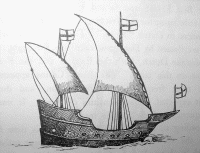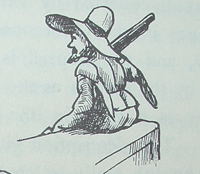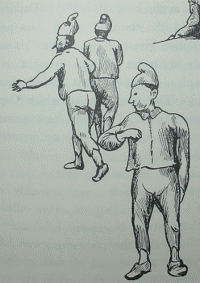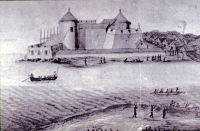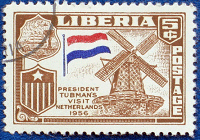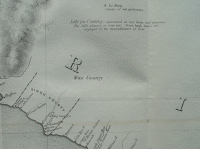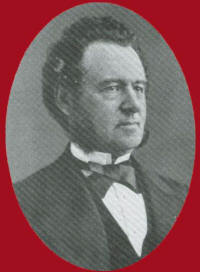|
Overview of the relations between Liberia and the Netherlands |
||||
|
|
|||||
|
The Dutch were among the earliest Europeans to take interest in the Liberian
coast and its inhabitants and were also probably the first whose interest
extended beyond strictly commercial transactions. The next ‘in depth’ report on the civilization of some of the Liberian
tribes, including the Kru, the Vai and the Gola, also came from a Dutchman, the
physician and geographer Olfert Dapper. His descriptions of the social structure
of some Liberian tribes, warfare initiation ceremonies and other tribal customs
were the most objective published in Europe up to that time. |
Olfert Dapper:
Musée Dapper, Paris, France "Dapper naît à Amsterdam, vers 1635, dans un quartier populaire ; il est baptisé à l’église luthérienne en janvier 1636. En mai 1658, il est inscrit à l’université d’Utrecht. Deux ans plus tard, il signe « doctor medicinæ ». Mais rien ne prouve qu’il ait reçu une formation médicale. Contrairement à ses contemporains, il n’a fait reproduire aucun portrait dans ses livres." (Dapper.com) |
||||
|
Willem Bosman, a leading agent of the Dutch Fort of Elmina, on the Gold Coast,
also visited the Liberian coast in 1701. His book published in Amsterdam and
later in German translation in Hamburg in 1708 remains to this day an
authoritative source of information on the social, political and economic
history of the Liberian people at the beginning of the 18th century. Bosman recorded in particular that upon his arrival at Cape Mount which he described as ‘a high mountain and from the sea it looks much like an island’, he was welcomed by the local people who took them to their village and offered him a pot of palm wine pending the arrival of King Jones of Cape Mount. ‘The King arrived with a lot of people around him. I got on my feet to meet the King outside the village. I made a deep bow to greet him. The King welcomed me heartedly and asked me to go with him to the village and sit down. I asked him if there was a good trade there for elephant teeth but the told me that there was not much in store and I got only two pieces”. Bosman described the King as an old man with gray hair and a beard, who was wearing a long flowing robe and was said to have 400 wives. He also noted that the society was very peaceful and the people preferred to settle their disputes with their neighbors through peaceful means rather than wars. Bows and arrows were used mainly for decoration. Of the people’s religion, Bosman reported that ‘they live only for their King and the governors appointed by the King and do not worry about anything else. Everyone works for the King”. At Cape Mesurado, Bosman wrote, the people were suspicious, frightened and less friendly than at Cape Mount. “When I asked them why they were suspicious, they told me that about two months earlier some Englishmen had landed from an English ship, destroyed their canoes, ravished their villages and took some of their people away as slaves’. Following the establishment of the independent Republic of Liberia in 1847, the Netherlands continued to show a sympathetic interest in the new State – the first to achieve independence in West Africa in modern times. The Dutch set up a permanent trading establishment on the Liberian coast and regularly sent ships to collect produce grown by Liberian farmers in exchange for a wide range of European goods. The first trading office, opened in 1855 by G. van Rijckevorsel, was later taken over by Hendrik Muller & Co, of Rotterdam and was eventually transferred to another Dutch firm, the Oost Afrikaansche Compagnie that, commonly know as O.A.C. has been a household word in Liberia since 1892. On the official level, the Netherlands was one of the first European countries to recognize Liberia. On December 20, 1862 the two countries concluded a Treaty of Friendship, commerce and Navigation, which is still in force. The documents of ratification of this Treaty were exchanged in London on June 3, 1864. Relations at the consular level were established in 1864 when Liberia appointed H. Muller of Hendrik Muller & Co. of Rotterdam to look after her consular interests in the Netherlands. The Netherlands reciprocated in 1872 with the appointment of Mr. Maarschalk of Greenville as its Consul in Liberia. In the late 1920s, at a time when racial discrimination in Europe was always liable to handicap the activities of black diplomats, Baron Otto van de Bogaerd van Terbrugge was appointed Liberia’s Envoy Extraordinary and Minister Plenipotentiary in Paris and played an important part in defending Liberia against the accusations of the colonial powers. In 1936, Bogaerd was appointed the first non-resident Liberia Minister in the Netherlands with residence in Paris. In 1954 the Netherlands consulate in Liberia became a Consulate-General for the whole of West Africa and the Netherlands representation in Liberia was raised to the level of a Legation. Later it was raised to an Embassy with Mr. G.P.G. Hooft Graafland as the first Ambassador of the Netherlands to Liberia. |
Willem Bosman: Naaukeurige beschryving van de Guinese goud-, tand- en slavekust, nevens alle desselfs landen, koningryken en gemenebesten; van de zeeden der inwoonders ...(etc.). 1704 (A new and accurate description of the coast of Guinea, divided into the Gold, the Slave, and the Ivory Coasts . . . with a particular account of the rise, progress and present condition of all the European settlements upon that coast; and the just measures for improving the several branches of the Guinea trade.) London: J. Knapton, 1705) More on Elmina (English) More on Elmina (Dutch) |
|||
|
The State visit of the late President and Mrs. William V.S. Tubman to the
Netherlands in 1956 and two visits of his Royal Highness, Prince Bernhard of the
Netherlands, to Liberia in 1958 and 1962 further strengthened the long
established relations between the two countries. Queen Juliana of the
Netherlands reciprocated with a State visit to Liberia in 1974. Dutch contributions to Liberia’s Development Following the voyages of the earlier Dutch seafarers whose reports on the
Liberian scene, useful as they were, related necessarily to what they had
observed in coastal areas, it was Swiss zoologist in Dutch employment, Johan
Büttikofer, who carried out some of the most important field studies in the
interior of Liberia between 1880 and 1882 and again in 1886 and 1887. The
results of his research, published in two volumes at Leiden in the Netherlands
in 1890, under the title of ‘Travel Pictures of Liberia’, contained not only
descriptions of many species of animals but also what were said to be the first
reliable maps of the central and western regions as well as valuable information
on geographical, ethnographical and other scientific data. His contribution to
the understanding of geographical, climatic and even geological conditions in
the interior of the country, as well as that of the outstanding Liberian
geographer Benjamin J.K. Anderson, were acknowledged by 20th century researchers. |
Büttikofer, J., 'Reisebilder aus Liberia - Resultate Geographischer, Naturwissenschaftlicher und Ethnographischer Unntersuchungen Während der Jahre 1879-1882 und 1886-1887', two volumes (Leiden, 1890). Büttikofer was born in Ranflüh im Emmenthal and studied
biology at Berne (Switzerland). In 1879 he joined the staff of the Royal
Zoological Museum in Leiden, becoming curator between 1884 and 1897. |
||||
|
Though the people of Liberia had smelted iron for many centuries and iron ore
deposits in the Kpo Range had been observed by B.J.K. Anderson in 1868, it was a
group of Dutch geologists who first established the existence in Liberia of a
large, workable deposit of high grade iron ore-asset which has since become the
country’s main source of wealth accounting for over 70 per cent of the value of
its exports. The discovery followed an agreement concluded in 1931 under which
a
syndicate from the Netherlands obtained from the Liberian Government the right
to carry out geological explorations in various parts of the country. The Dutch
syndicate was interested mainly in gold and diamonds. But in the course of their
explorations, the team of Dutch geologists sent by the syndicate came across a
series of ridge dominated by a high cliff of reddish rock which geologist H.
Terpstra immediately recognized as a valuable reserve of ore of unusual purity.
The deposit, known as Bomi Hill, turned out to be one of the richest in the
world, averaging 66 to 68 per cent of pure iron and comparable only to the famous
Kiruna deposit in Sweden. |
Benjamin Anderson, 'Journeys to Musadu', Narrative of a Journey to Musardu the capital of the Western Mandingoes Together with Narrative of the expedition despatched to Musahdu by the Liberian Government under Benjamin J.K. Anderson in 1874.
Also see: |
|||
|
At present1, the Dutch company Hoogovens, through its German branch
Hoesch, participates in the exploitation of the iron deposit operated by the
Bong Mining Company. Dutch know-how, often acquired in the rubber plantations of Indonesia, also proved an important asset in the development of the Liberian rubber industry, which is the largest employer of labor in the country. Though only the Salala Plantation of the Salala Rubber Corporation (established in 1959) involved Dutch investment, American concessions such as Firestone and B.F. Goodrich, as well as Liberian planters, have made use of Dutch expertise in this specialized field. In the important realm of transportation the Netherlands West Africa Line has maintained a regular service between the Netherlands and Liberian since 1920 thus helping the promote trade not only with the Netherlands but also with the rest of Europe. The Royal Dutch Airlines (K.L.M.) was one of the first international airlines to operate scheduled flights to and from Liberia and, with four flights a week, still provides the most frequent service to Europe and some parts of West Africa. In the timber field, Liberia’s latest fast developing industry, the Netherlands is represented by the Maryland Logging Company which pioneered this industry in the east of the country and is presently engaged in setting up a wood processing plant near Harper. The first attempt to exploit heavy minerals found in the beach sands of south-eastern Liberia is being undertaken by an old-established Dutch firm – William H. Muller (Ores and Mining) in collaboration with the Bos Kalis - Westminster Dredging group. Another Dutch firm, J.G. Luyken, has introduced new techniques in planning, research and accounting. |
1 Here and elsewhere reference is made to an unknown year. Though the origin of the text could not be established with certainty it is very likely that it dates from the late 1960s early 1970s. | ||||
|
The leading Dutch trading firm, O.A.C. which began operations in Liberia before
the turn of the 19th century, maintaining also for some decades the only produce
buying stations in some parts of the country, was joined in 1962 by the Hoeks
(Liberia Ltd.) which specializes in the importation and distribution of general
merchandise, building materials, provisions and textiles. In the late 1960s there were about 1,800 Dutch nationals in Liberia engaged in various fields of endeavor including commerce, mining, industry and agriculture, as well as some working within the framework of the United Nations. Their number dwindled down to some 600 in the 1970s. The most notorious of them would become Gus van Kouwenhoven. |
 Gus
van Kouwenhoven Gus
van Kouwenhovenarrested in the Netherlands in March 2005. He is accused of committing war crimes against Liberians and violating a U.N. arms embargo. His trial and acquittal. |
|||
| Source: The source of this text is unknown. It probably dates from the late 1960s, early 1970s and may originate from the files of the Netherlands Royal Embassy in Monrovia, Liberia. Despite extensive research this could not be confirmed. | |||||
|
|
|||||
| A Dutch account of Liberia in the 17th c. | |||||
|
©
fpm van der kraaij
|
